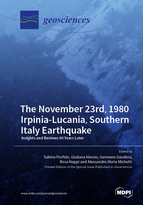The November 23rd, 1980 Irpinia-Lucania, Southern Italy Earthquake: Insights and Reviews 40 Years Later
A special issue of Geosciences (ISSN 2076-3263). This special issue belongs to the section "Natural Hazards".
Deadline for manuscript submissions: closed (30 October 2020) | Viewed by 50828
Special Issue Editors
Interests: natural hazards; active tectonics; historical and recent seismicity; seismic risk; seismic hazard; environment; paleoseismology; floods; historical floods; disasters induced by earthquakes; cultural heritage; resilience
Special Issues, Collections and Topics in MDPI journals
Interests: seismotectonics; earthquake geology; natural hazard; geoheritage
Special Issues, Collections and Topics in MDPI journals
Interests: tectonics; structural geology; geology; exploration geophysics; plate tectonics; seismics; quaternary geology; geodynamics; geophysics; applied geophysics; seismology; earthquake
Special Issues, Collections and Topics in MDPI journals
Interests: seismotectonics; earthquake geology and paleoseismology; seismic hazard; tectonic geomorphology; active tectonics; historical and recent seismicity; geological mapping; volcanic geomorphology
Special Issues, Collections and Topics in MDPI journals
Special Issue Information
Dear Colleagues,
The November 23rd, 1980 Irpinia-Lucania, Southern Italy earthquake: insights and reviews 40 years later.
Soon, 40 years will have passed since the earthquake that struck Irpinia-Lucania (Southern Italy) on 23 November 1980 (MS 6,9 I Max X MCS).
This earthquake, besides being remembered as the most devastating seismic event in Italy in terms of loss of human life and destruction of cultural heritage in the last 100 years, is still considered to be a key event for the study of seismicity in Italy, marking the development of modern seismology, quaternary geology, and active tectonic studies, including the growth of the emerging methodology of paleoseismology in Italy. In this Special Issue, we want to collect key contributions that will help the scientific community to update the results obtained from the study of this earthquake after 40 years. In fact, the time has come to reconsider the many, still open, fundamental research issues so richly illustrated during the Irpinia-Lucania event.
Our goal is to gather several contributions from researchers with different expertise, encouraging a multidisciplinary approach that highlights the most important aspects of the earthquake from a seismological and geological point of view, without neglecting the reconstruction of cultural heritage, the resilience of the population, and the socioeconomic development of the internal areas of the Southern Apennines after the earthquake. No doubt, lessons learned from the Irpinia-Lucania event are relevant at the local level, for the whole Mediterranean region, and in similar seismotectonic and cultural environments around the world.
Dr. Sabina Porfido
Dr. Giuliana Alessio
Dr. Germana Gaudiosi
Dr. Rosa Nappi
Prof. Alessandro Maria Michetti
Guest Editors
Manuscript Submission Information
Manuscripts should be submitted online at www.mdpi.com by registering and logging in to this website. Once you are registered, click here to go to the submission form. Manuscripts can be submitted until the deadline. All submissions that pass pre-check are peer-reviewed. Accepted papers will be published continuously in the journal (as soon as accepted) and will be listed together on the special issue website. Research articles, review articles as well as short communications are invited. For planned papers, a title and short abstract (about 100 words) can be sent to the Editorial Office for announcement on this website.
Submitted manuscripts should not have been published previously, nor be under consideration for publication elsewhere (except conference proceedings papers). All manuscripts are thoroughly refereed through a single-blind peer-review process. A guide for authors and other relevant information for submission of manuscripts is available on the Instructions for Authors page. Geosciences is an international peer-reviewed open access monthly journal published by MDPI.
Please visit the Instructions for Authors page before submitting a manuscript. The Article Processing Charge (APC) for publication in this open access journal is 1800 CHF (Swiss Francs). Submitted papers should be well formatted and use good English. Authors may use MDPI's English editing service prior to publication or during author revisions.
Keywords
- 1980 post-earthquake emergency phase—the response of the scientific community
- Focal parameters of the 1980 earthquake
- Macroseismic studies: a historical and modern perspective
- Primary and secondary environmental effects induced by the 1980 earthquake
- Cultural heritage, damage, and reconstruction of small towns and cities
- Geology, active tectonics, and paleoseismology of the areas affected by the 1980 earthquake
- New perspective on seismic hazard evaluation








